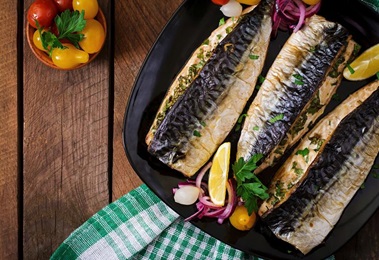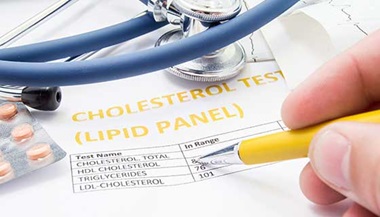Why Cholesterol Matters for Women
Reviewed By:
Ah, cholesterol and triglycerides. We hear about them all the time. Even foods that might seem good for you on the surface, like fruit-filled yogurt or bran muffins, can contribute to abnormal levels if they contain too much saturated fat or refined sugar, says Erin Michos, M.D., associate director of preventive cardiology at the Ciccarone Center for the Prevention of Heart Disease.

What’s more, many women are at risk for high cholesterol and don’t realize it. “Approximately 45 percent of women over the age of 20 have a total cholesterol of 200 mg/dl and above, which is considered elevated — but a survey by the American Heart Association found that 76 percent of women say they don’t even know what their cholesterol values are,” Michos says.
Scarier still: Triglycerides, a type of blood fat typically measured alongside cholesterol, are even more risky in women compared with men. This is a problem because women’s cholesterol levels can fluctuate quite a bit after menopause and tend to increase with age, putting us at greater risk of heart disease and stroke. Knowing your cholesterol numbers and how to control them is a big step toward staying healthy.
Understanding the Highs and Lows of Cholesterol
You know that too much is dangerous. But what is cholesterol, anyway? Where does it come from? And is it all bad?
Cholesterol is a waxy substance that is found in every cell in the body. It’s either made by the body or absorbed from food. Your body needs cholesterol to make important steroid hormones such as estrogen, progesterone and vitamin D. It’s also used to make bile acids in the liver; these absorb fat during digestion.
So some cholesterol is necessary — but bad cholesterol is something you can do without. Excess bad cholesterol in the bloodstream can deposit into the body’s arteries. These deposits are called plaques and result in atherosclerosis, or hardening of the arteries. This is the major cause of heart attacks, strokes and other vascular problems.
Your total cholesterol level is a measure of the total amount of cholesterol circulating in your bloodstream, which includes several components:
- LDL cholesterol: LDL stands for “low-density lipoprotein.” This is known as the “bad” cholesterol, which directly contributes to plaque buildup in the arteries. Very low density lipoprotein, or VLDL cholesterol, is another type, which is a precursor to LDL.
- Total cholesterol is VLDL cholesterol plus LDL cholesterol plus HDL cholesterol.
- HDL cholesterol: HDL stands for “high-density lipoprotein.” Experts think at optimal levels (around 50 mg/dl) it might help the body get rid of LDL cholesterol.
So bits of this stuff circulate through your system, and here’s what happens: The bad parts – the LDL particles – like to stick to the lining of your arteries, like soap scum in pipes. As it sticks there, it generates an inflammatory response and your body starts converting it into plaque. Plaque in your blood vessels makes them stiffer and narrower, restricting blood flow to vital organs such as your brain and heart muscle, leading to high blood pressure. Additionally, chunks can break off and cause a heart attack or a stroke.
And guess what? This buildup can start as early as your 20s.
What to Know About Triglycerides
In addition to cholesterol, you might hear about your triglycerides, another kind of fat found in the bloodstream. Women should pay particular attention to this. “A high level of triglycerides seems to predict an even greater risk for heart disease in women compared with men,” says Michos.
When you take in more calories than you need, your body converts the extra calories into triglycerides, which are then stored in fat cells. Triglycerides are used by the body for energy, but people with excess triglycerides have higher risk of medical problems, including cardiovascular disease. Drinking a lot of alcohol and eating foods containing simple carbohydrates (sugary and starchy foods), saturated fats and trans fats contributes to high triglycerides. High levels may also be caused by health conditions such as diabetes, an underactive thyroid, obesity, polycystic ovary syndrome or kidney disease.
Triglycerides also circulate in the bloodstream on particles that may contribute to plaque formation. Many people with high triglycerides have other risk factors for atherosclerosis, including high LDL levels or low HDL levels, or abnormal blood sugar (glucose) levels. Genetic studies have also shown some association between triglycerides and cardiovascular disease.

High Cholesterol: Prevention, Treatment and Research
Cholesterol is a natural component in everyone’s blood. However, when you have too much of this fatty substance, it’s considered hyperlipidemia, hypercholesterolemia or high blood cholesterol—a major risk factor for heart attack, heart disease and stroke. About 71 million Americans have high cholesterol.
What’s your cholesterol level, anyway?
A standard lipid blood test usually measures the concentration of total cholesterol, HDL cholesterol, and triglycerides levels. The LDL-cholesterol level is typically estimated from these numbers using a well-established formula that has been more recently revised and improved by researchers at Johns Hopkins.
So what are your target numbers? According to Michos, an ideal LDL cholesterol level should be less than 70 mg/dl, and a woman’s HDL cholesterol level ideally should be close to 50 mg/dl. Triglycerides should be less than 150 mg/dl. As Michos notes, total cholesterol levels well below 200 mg/dl are best.
Why Cholesterol Affects Women Differently
In general, women have higher levels of HDL cholesterol than men because the female sex hormone estrogen seems to boost this good cholesterol. But, like so much else, everything changes at menopause. At this point, many women experience a change in their cholesterol levels — total and LDL cholesterol rise and HDL cholesterol falls. This is why women who had favorable cholesterol values during their childbearing years might end up with elevated cholesterol later in life. Of course, genetics and lifestyle factors can play big roles, too.
How to Lower Your Cholesterol
If you’ve been told that you have high cholesterol — or you just want to prevent it — what can you do?
There are several ways to manage it, including:
Medication: Depending on your overall cardiovascular disease risk, you might be treated with a cholesterol-lowering medication, such as a statin. The decision to use a statin is based on a woman’s overall risk for heart attack and stroke including all these factors and the LDL cholesterol value.
If you already have vascular disease or evidence of atherosclerosis, or if you are at high risk for cardiovascular disease, a statin for prevention is strongly recommended because this treats the plaque in the arteries, and lowers LDL cholesterol, Michos says.
Diet and lifestyle: “Diet and lifestyle are very important to help maintain healthy cholesterol levels. Even for women who are recommended to take cholesterol-lowering medications, a healthy lifestyle helps these drugs work better,” says Michos.
Here’s how to maintain a lifestyle that promotes healthy cholesterol levels:
- Maintain a healthy body weight
- Don’t smoke.
- Exercise for at least 30 minutes five or more days per week.
- Eat a diet rich in fruits, vegetables, lean protein and high amounts of soluble fiber such as beans and oats, which can reduce LDL.
- Avoid sugar-sweetened drinks and fruit juices — opt for water and unsweetened tea instead — and minimize your intake of other simple carbohydrates like baked goods and candy.
- Drink alcohol in moderation, especially if you have elevated triglycerides.
- Consider the Mediterranean diet, which is rich in fruits, vegetables, grainy breads and fish. Use olive oil (instead of butter) and spices (instead of salt).
- Eat monounsaturated and polyunsaturated fats — such as those found in olive oil, nuts and fatty fish like salmon. They can actually have a positive effect on cholesterol, Michos says, by reducing the amount of LDL in the blood and reducing inflammation in the arteries, especially when they replace saturated fats in the diet.
Add these to your shopping list:
- Fatty fish such as salmon, trout, mackerel, sardines and albacore tuna
- Nuts, including walnuts, pecans, almonds and hazelnuts
- Olive oil to drizzle lightly over your salads and vegetables
While nobody wants to have high cholesterol, there are plenty of ways to keep it in check. “With regular checkups and attention to what you eat, it’s possible to manage your cholesterol and blood fats to keep your heart healthy,” says Michos.

Sign Up for Our Free Newsletter
One of the best things you can do to protect and improve your health is to stay informed. Your Health is a FREE e-newsletter that serves as your smart, simple connection to the world-class expertise of Johns Hopkins.







